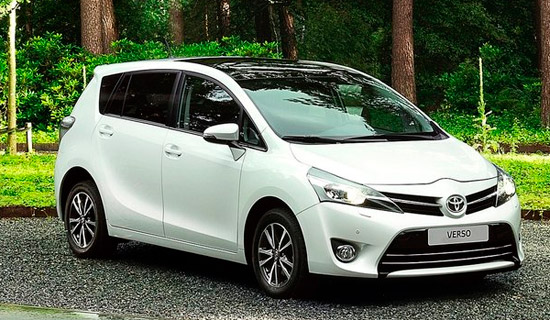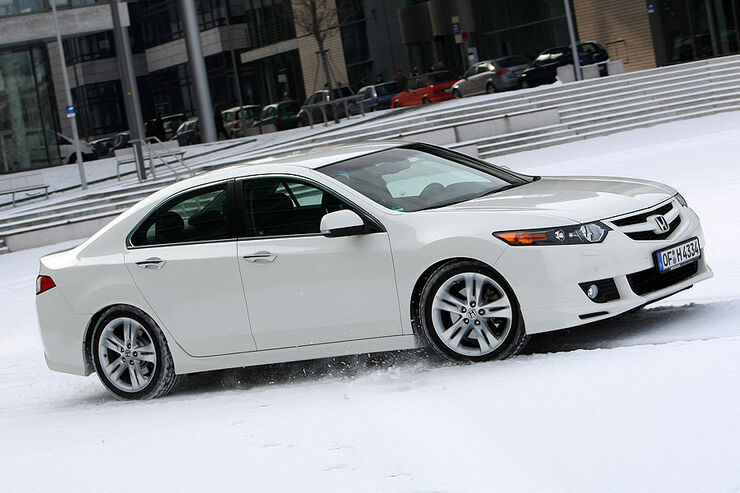
New Toyota Corolla Verso
The base is a floor slab adapted from… Avensis. Compared with the previous generation, the length of the car has increased by 70 mm, and the width is 20 mm. As a result, both the wheelbase and the wheelbase of the car have increased. As a result, it is possible to create a more spacious and spacious interior, and on the other hand, the behavior of the car on the road is improved. The level of soundproofing has also been borrowed from Avensis, due to the type of materials used.
The exterior looks more like an Avensis than a new Corolla in terms of exterior design. Therefore, the last term has disappeared from the name of the car, and now we only have Toyota Verso.
The interior of the car, as in the first generation, is seven-seater. The two additional seats fold into the floor of the luggage compartment. When they are all unfolded, behind them is a luggage compartment that holds 178 liters, which is almost three times more than in the first generation. This value is for the most straight third-row seatbacks. They can be installed at different angles, increasing travel comfort. At maximum tilt, the luggage compartment holds 155 liters. Folding these chairs (as well as laying them out) is simple, quick and does not require much effort. Hiding them, we get a trunk with a capacity of 440 liters, which, by folding the second row of seats, can be increased to 982 liters. In the five-seater version, the absence of a third row of seats increases the last two values to 484 liters and 1026 liters, respectively.
During the presentation, we had at our disposal a set of luggage with a bicycle and skis, as well as five assistants, so we could practice all possible settings, not only folding the seats, but also really looking for passenger comfort. According to Toyota, the Easy Flat-7 system allows for 32 different interior configurations. We haven't tried them all, but folded the chairs in different ways, and customizing the interior is really easy, effortless, and enjoyable. However, the car's compact dimensions mean that when you're planning to travel with 7 people, it's worth considering their size. Seven adult men 180 cm tall can forget about driving comfort. Children or small adults are best directed to the third row of seats.
The family functionality of the car also implies a large number of compartments in the cabin. Door pockets are a must in every car, but the Verso also has two floor storage in front of the middle row of seats and a stowage box under the front passenger seat. On the tunnel between the front seats there are two cup holders and an armrest with a compartment for bottles. At the base of the center console, which houses the shift knob, there are also two small pockets for small items such as a mobile phone or, for example, gate keys. You can get rid of the latter thanks to the HomeLink system included in the options. These are three upholstered buttons that allow you to remotely control any home automation system. These can be, for example, automatic devices that open gates and garage doors and turn on the exterior lighting of the house.
The dashboard also has three lockable compartments, one of which is cooled. The family configuration is completed by a separate small rear-view mirror for keeping an eye on children in the rear seats.
The interior of the car is beautiful and interestingly stylized. The instrument panel is centrally located on the dashboard, but has almost traditional round tachometer and speedometer dials clearly facing the driver. The center console is functional and clear, and at the same time quite elegant. The upper part of the dashboard is sheathed with soft, pleasant to the touch material. Personally, I'd rather it be trimmed with the things you actually touch, i.e. the center console or storage compartments. But well, soft top boards and hard bays are more of a trend used by all manufacturers.
The chassis of the car provides a fairly comfortable journey. In some places, the asphalt with holes in the Masurian villages did not give us much trouble. The suspension was adapted to the large dimensions of the body by changing the geometry of the front McPherson struts and the rear torsion beam. The car drove confidently and confidently along the winding roads of the Masurian forests.
The range of engines also ensures driving pleasure, with the weakest unit delivering 126 hp. This is a two-liter turbodiesel that accelerates the car to 100 km / h in 11,7 seconds and provides an average fuel consumption of 5,4 l / 100 km. The two-liter turbodiesel is a new unit in the Verso lineup. The basis, i.e. the first item in the price list is a 1,6-liter gasoline engine with 132 hp. It is a little more dynamic, because Verso accelerates “to hundreds” in 11,2 seconds, and burns 6,7 l / 100 km. Other power units are a 1,8-liter gasoline engine with 147 hp. and 2,2 D-CAT turbodiesel, available in two power options, 150 and 177 hp. In the first version we have an automatic transmission, in the second - a manual one. The combustion and acceleration for these units are respectively: 6,9 l and 10,4 s, 6,8 l and 10,1 s and 6,0 l and 8,7 s. The 1,8 engine is also available with automatic transmission Multitronic S and in In this case, the acceleration is 11,1 s, and the average fuel consumption is 7,0 liters.
The base standard was called the Luna. We have, among other things, 7 airbags, VSC+ stabilization system, HAC hill start assist, manual air conditioning, central locking and radio with CD and MP3 playback.
The range of additional equipment is very wide. It includes parking sensors, a rearview camera with a display in the rearview mirror, a luggage net system and a dog screen separating the luggage compartment from the cab.
Toyota hopes to sell 1600 of these vehicles in Poland this year. 200 orders have already been received as a result of the open days. Having a truck-approved version is also likely to be a strong advantage.

